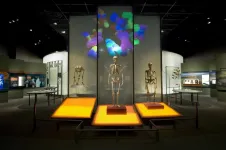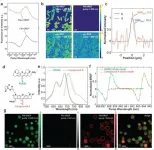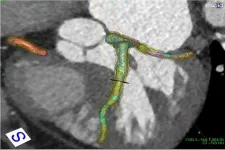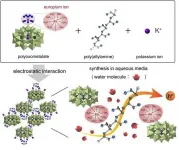(Press-News.org) BETHESDA, Md. -- The COVID-19 pandemic heavily influenced spending on prescription drugs in the U.S. in 2020, according to the ASHP's (American Society of Health-System Pharmacists) National Trends in Prescription Drug Expenditures and Projections for 2021. Shifts in care related to the pandemic will continue to be a significant driver of drug expenditures in 2021, along with uptake in the use of biosimilars, a large pipeline of new cancer drugs, and increased approvals of specialty medications.
Prescription drug spending in 2020 grew at a moderate rate of 4.9% to $535.3 billion. Increased utilization drove the growth, which accounted for 2.9% of the total increase. Spending on new drugs accounted for 1.8% of the increase, and price changes accounted for 0.3%.
"Reflecting the overarching impact of COVID-19 on healthcare, ASHP's drug expenditures report illustrates the factors that can impact hospital and health-system budgets," said Daniel J. Cobaugh, Pharm.D., FAACT, DABAT, vice president of publishing at ASHP and editor-in-chief of AJHP. "We provide this annual report to help hospital and health-system leaders, policy makers, and others understand drug expenditure patterns to anticipate future growth and spending."
Drug expenditures in nonfederal hospitals declined 4.6%, while drug spending in home care settings increased 13%. Drug expenditures in nonfederal hospitals spiked in the three weeks immediately following the March 8, 2020, lockdown. Spending then dropped precipitously, remaining low for 19 weeks before rebounding. When those volatile early weeks of the pandemic are removed from the data, drug spending in hospitals showed modest growth compared to 2019.
Top drugs by overall spending were the immunosuppressive adalimumab for immune disorders such as arthritis and Crohn's disease; apixaban, a treatment to prevent blood clotting in patients with atrial fibrillation; and insulin glargine.
Many effects of the pandemic are likely to persist in 2021 and could have a dramatic impact on drug expenditures into 2022, said the report's lead author, Eric Tichy, Pharm.D., M.B.A., division chair, supply chain management at Mayo Clinic, Rochester, Minnesota. "Hospital and health-system pharmacy leaders should expect to continue suffering from drug expenditure whiplash in 2021 and beyond as they manage the implications from COVID-19, including the commercial availability of new high-cost drug therapies and shifts in site of care throughout the evolution of the pandemic."
As drugs approved under emergency use authorizations transition to full Food and Drug Administration (FDA) approval, expenditures for agents like remdesivir and monoclonal antibody cocktails will move from the federal government to the sectors where care is delivered. Remdesivir exceeded expenditures for all drugs in nonfederal hospitals, despite it only being commercially available for the final three months of 2020. In addition, approvals for several new drugs for the management of COVID-19 will affect spending in coming years.
Hospitals and health systems are also likely to see a rebound of prescription drug expenditures resulting from higher utilization of acute care services due to patients' reluctance to get preventative care during the pandemic.
The report also predicts the expanded use of biosimilars over innovator products will serve as a powerful deflationary force on drug expenditures for the foreseeable future. Expected approvals of new biosimilars for adalimumab, ranibizumab, and pegfilgrastim in 2021 and 2022, will increase competition and may cause further reductions in expenditures.
Other factors expected to influence prescription drug spending in 2021 include a large pipeline of new cancer drugs, the development of treatments for rare diseases, and expected FDA approval for several specialty drugs. The growth in spending on specialty drugs continues to outpace the rest of the market and could exceed 50% of overall drug expenditures in 2021. Efforts by payers to implement site-of-care restrictions will push more use of high-cost specialty drugs out of hospitals and into lower-cost sites, including ambulatory infusion centers and homecare.
The report is published online ahead of print at https://academic.oup.com/ajhp/advance-article-abstract/doi/10.1093/ajhp/zxab160/6242438?redirectedFrom=fulltext and will appear in print in the July 15 edition of AJHP.
INFORMATION:
Published in the Advanced Functional Materials, University of Minnesota researcher Hongbo Pang led a cross-institutional study on improving the efficacy of nucleotide-based drugs against prostate cancer and bone metastasis.
In this study, Pang and his research team looked at whether liposomes, when integrated with the iRGD peptide, will help concentrate antisense oligonucleotides (ASOs) into primary prostate tumors and its bone metastases. Liposomes are used as a drug carrier system, and ASOs are a type of nucleotide drug.
More importantly, they investigated whether this system ...
DUARTE, Calif. -- Scientists at City of Hope, a world-renowned independent research and treatment center for cancer and diabetes, have developed a novel, noninvasive liquid biopsy test for detecting lymph node metastasis in individuals with high-risk T1 colorectal carcinoma. Research on the development of the blood test was reported in a END ...
A new study is the first-ever to identify the genes for creativity in Homo sapiens that distinguish modern humans from chimpanzees and Neanderthals. The research identified 267 genes that are found only in modern humans and likely play an important role in the evolution of the behavioral characteristics that set apart Homo sapiens, including creativity, self-awareness, cooperativeness, and healthy longevity. The study, led by an international and interdisciplinary team of researchers from the American Museum of Natural History and Washington University among other institutions, is published today in the journal Molecular Psychiatry.
"One of the most fundamental questions about ...
It has been a long pursuit to develop super-resolution imaging techniques for Raman microscopy, which has intrinsic advantages of chemical specificity over the fluorescence counterpart. Despite the perceived importance and extensive research efforts, true super-resolution (defined as diffraction-unlimited) Raman imaging of biological systems in the optical far-field remains challenging due to the deficiency in sensitivity for conventional Raman scattering. Consequently, those reported super-resolution vibrational imaging methods have to base on excitation saturating, ...
The Endangered dryas monkey (Cercopithecus dryas), endemic to the Democratic Republic of the Congo, is one of Africa's most mysterious primates. The discovery of the dryas monkey killed by a hunter in the buffer zone of Lomami National Park in 2014 has prompted field research of this small species (5-7 pounds). However, they are difficult to detect because they live in dense vegetation in secondary forest thickets.
Using non-invasive research and no-flash camera traps from 2014 to 2019, scientists from Florida Atlantic University in collaboration with researchers from the FZS-Lomami Project, Democratic Republic of the Congo, now have picture-perfect details on this elusive species. They have confirmed ...
Astronomers have discovered a pulsar--a dense and rapidly spinning neutron star sending radio waves into the cosmos--using a low-frequency radio telescope in outback Australia.
The pulsar was detected with the Murchison Widefield Array (MWA) telescope, in Western Australia's remote Mid West region.
It's the first time scientists have discovered a pulsar with the MWA but they believe it will be the first of many.
The finding is a sign of things to come from the multi-billion-dollar Square Kilometre Array (SKA) telescope. The MWA is a precursor telescope for the SKA.
Nick Swainston, a PhD student at the Curtin University node of the International Centre for Radio Astronomy Research (ICRAR), made the discovery while processing data collected as part ...
Coronary artery disease (CAD) is the most common form of heart disease and is present in about END ...
Protons are the next big thing when it comes to fuel cell technology. The subatomic exchange produces power on a scale that challenges contemporary solid-state fuel cell technology, used to help power space shuttles. To realize the proton-based technology sooner, an international team of researchers have developed a hybrid material that effectively transports protons at high temperatures and humidity -- two major challenges in past attempts.
The results were published on April 19 in ACS Applied Materials & Interfaces, a journal of the American Chemical Society.
The team, led by ...
A new Portland State study challenges the idea that youth with cognitive disabilities are unable or lack potential to pursue a career in science, technology, engineering and mathematics.
In a study using national data on more than 15,000 adolescents, the researchers found that undergraduates with medicated ADHD or autism appear to be more likely to major in STEM than youth without cognitive disabilities, and youth with autism have the most positive STEM attitudes.
Dara Shifrer, the lead author and an associate professor of sociology at PSU, says that increasing access to STEM fields for youth with disabilities depends not only on encouraging them to pursue STEM majors but also to enroll in college because STEM occupations often require bachelor's degrees at ...
Graphene is a two-dimensional material in which carbon atoms are arranged in hexagonal structures, and it has unique physical and chemical properties such as sub-nanometer thickness, chemical stability, mechanical flexibility, electrical and thermal conductivity, optical transparency, and selective permeability to water. Due to these properties, various applications of graphene in transparent electrodes, desalination, electrical energy storage, and catalysts have been vigorously studied.
Because graphene is an extremely thin material, for practical uses, it has to be deposited on top of other materials that serve as substrate. One of the research subjects which is of great scientific ...






